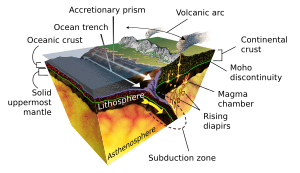Volcanic arc facts for kids
A volcanic arc is a line of volcanoes that looks like a curve or an arc. These volcanoes can be islands or mountains. They are found near the edges of continents. Volcanic arcs form because of something called plate tectonics. This is when one huge piece of the Earth's crust, called a tectonic plate, slides under another plate. This process is known as subduction.
When one plate goes deep under another, it creates hot, melted rock called magma. This magma then rises up through the Earth's crust. When it reaches the surface, it erupts and forms volcanoes. This is how a volcanic arc is born!
Where Does the Magma Come From?
You might think the magma comes from the melted oceanic plate itself. But it's actually a bit different! The plate that slides down carries a lot of sediment (like sand and mud) and changed basalt rock. Both of these are full of water and other gases.
As the plate goes deeper into the Earth, these water and gases are released. They move upwards into the hot rock above the sliding plate. This makes the melting point of that rock much lower, so it melts and forms magma. This new magma, full of gases from the sinking plate, then makes its way to the surface to create the arc volcanoes.
Types of Volcanic Arcs
There are two main kinds of volcanic arcs:
- Oceanic (Island) Arcs: These are chains of volcanic islands in the ocean.
- Continental Arcs: These are chains of volcanoes on a continent.
An example of a continental volcanic arc is the Cascade Mountain Range in western North America. This range includes famous volcanoes like Mount St. Helens.
A great example of an island arc is the Aleutian Islands. This is a long chain of islands that stretches for almost 2,500 kilometers (about 1,550 miles). It goes from the Alaskan Peninsula all the way to the Near Islands. The Aleutian Arc has about 80 major volcanoes. Nearly half of them have erupted in recorded history!
Images for kids
See also
 In Spanish: Arco volcánico para niños
In Spanish: Arco volcánico para niños




